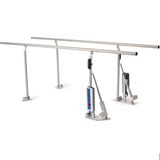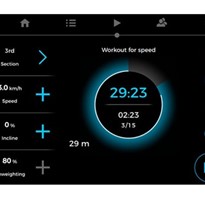Galileo Vibration training assists in gait training, fall prevention, increased muscle power through human gait simulation.
Simulation of human gait
- Unlike other training platforms with a vertical (up and down) movement, the tilting movement of Galileo Training simulates human gait in a physiological way.
- Only by this side-alternating movement during Galileo Training is the spine stimulated by a slight lateral tilt of the pelvis. On training platforms with a vertical movement, however, the spine is continually compressed.
- The physiological stimulation of the spine by the side-alternating function of Galileo allows the back and abdominal muscles to be targeted. On training platforms with a vertical movement this is possible, but to a very limited extent only.
- As humans we attempt to keep the head in a steady and upright position as the balance and visual systems function optimally only when in a state of rest. Due to the design of the machine, no significant vibrations are transferred to the head during Galileo Training because the training platform only simulates human gait. The body, therefore, is able to maintain a stable torso and head.
- Because Galileo Training produces similar stimulus patterns used when walking, in addition to the basic muscle functions itself, the interaction between different muscle groups and their coordination, is developed perfectly resulting in an increase in muscle power. In the elderly especially, muscle power is the relevant factor in preventing falls that can cause hip and femoral fractures. Due to its low burden on the cardiovascular system Galileo Training is ideal for the elderly.
- During Galileo Training the entire chain of muscles in the leg, and all the way up to the trunk, are targeted. Specific training on individual muscle groups can be achieved by simply altering body posture and tension.


Get 3+ quotes so you can compare and choose the supplier that's right for you















-205x205.jpg)





